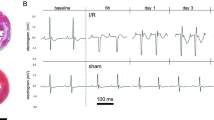Summary
The effect of a pure α-adrenergic agent, methoxamine on ventricular fibrillation (VF) amplitude and the relation between hemodynamic parameters and survival in a rodent cardiopulmonary resuscitation (CPR) model were studied. Our results suggested that: 1) VF amplitude decreased during untreated VF, but it increased during pericardial chest compression; 2) methoxamine significantly increased the mean aortic pressure (MAP) and coronary perfusion pressure (CPP) but not VF amplitude, and the survival also increased due to elevation of CPP; and 3) all surviving animals with successful defibrillation had a higher VF amplitude.
Similar content being viewed by others
References
Berker L B, Smith D W, Rhodes K V. Incidence of cardia arrest: anegleted factor in evaluating survival rates. Ann Emerg Med, 1993, 22:86
Becker L B, Han B H, Meyer P Met al. Racial difference in the incidence of cardiac arrest and subsequent survival. The CPR Chicago project. N Engl J Med, 1993, 329:600
Von Plata J, Wagner O, von Planta Met al. Determinants of survival after rodent cardia arrest: implications for therapy with adrenergic agents. Int J Card, 1993, 38: 235
Von Planta I, Wei M N, von Planta M. Cardiopulmonary resuscitation in the rat. J Apl Physiol, 1988, 65:2641
Neumar R, Brown C G, Ligten P Vet al. High-energy phosphate metabolism during ventricular fibrillation. Ann Emerg Med, 1989, 18:472
Niemann J T, Cairns C B, Sharma Jet al. Treatment of prolonged ventricular fibrillation. Circulation, 1992, 85:281
Reich H, Angelos M, Safer P. Cardiac resuscitability with cardiopulmonary bypass after increasing ventricular fibrillation times in dogs. Ann Emerg Med, 1990, 19: 887
Livesoy J J, Follette D M, Feu KHet al. Optimizing myocardiac supply-demand balance with ot-adrenergic drugs during cardiopulmonary resuscitation. J Thorac Cardiovasc Surg, 1978, 76:244
Idriss S F, Anstadt M P, Anstadt G Cet al. Cardiac compression significant improves defibrillation efficacy. Circulation, 1993, 88: I-592
Weaver W D, Cobb L A, Dennis Det al. Amplitude of ventricular fibrillation. Ann Int Med, 1985, 102:53
Author information
Authors and Affiliations
Additional information
This project was supported by grants from the Swiss National Research foundation (No. 32-32359. 91).
Rights and permissions
About this article
Cite this article
Tiecheng, P., Shuhua, Z., von Planta, M. et al. An experimental comparative study on the characteristics of ventricular fibrillation during cardiac arrest and methoxamine administration. Current Medical Science 17, 94–97 (1997). https://doi.org/10.1007/BF02888243
Received:
Published:
Issue Date:
DOI: https://doi.org/10.1007/BF02888243




